 [Updated Feb. 3, 2019, with additional options.]
[Updated Feb. 3, 2019, with additional options.]
Most of the time, Apple Final Cut Pro X works reliably. But, every so often, things go weird. Here’s a list of things to try before you call Apple Support.
These are listed in order. Try each of these steps, then see if FCP X starts working properly. If it is, then stop there. If not, keep going. If nothing works, then please contact Apple Support.
NOTE: If you are looking for general trouble-shooting procedures, read this. If you are looking for Final Cut Pro 7 trouble-shooting tips, read this.
STEP 1: RESTART
Quit Final Cut, then restart your computer. It is amazing what gets fixed simply by restarting.
STEP 2: TRASH FCP X PREFERENCES
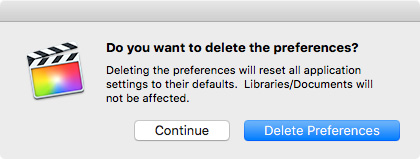
Quit FCP X. Then, press and hold the Option + Command keys while clicking the Final Cut icon in the Dock. This message then appears.
Click the blue Delete Preferences button to restore Final Cut’s preferences to the factory default.
Trashing FCP X preferences does NOT delete any of your libraries, media, edits or projects. It DOES empty the Recent Libraries list in the File menu, resets all FCP X preferences to defaults and resets the internal settings of FCP X to their Apple defaults. For this reason, make sure you know where your libraries are stored before deleting preferences so you can find them manually after this reset.
STEP 3: SAFE BOOT
A Safe Boot cleans up problems with how files are stored on your hard disk. A Safe Boot is also the best way to delete plug-ins that are malfunctioning, files that refuse to be deleted, or files that remain open after an application quits.
While pressing the Shift key, restart your computer. Continue holding the Shift key until the computer restarts AND you see the small, white thermometer start to scroll across the bottom of your screen.
BIG NOTE: YOU CAN NOT RUN FCP X in Safe Mode. This procedure is for maintenance and repair, not operating your computer.
Your computer will prompt you for your user name and password, even if you have auto-logon turned on. You know you’re in Safe Mode because, when the log-in screen appears, the words “Safe Boot” appear in red in the upper right corner of your screen.
This does several things:
NOTE: Safe Boot is an excellent maintenance procedure for your entire computer, not just Final Cut. It was designed by Apple and I recommend you run this once a week. in the past, once I’m logged into Safe Mode, I used to run First Aid, but now, there’s a better way to repair your boot drive.
To restore your computer to normal operation, simply restart it without pressing any keys.
UPDATE — STEP 4: REPAIR THE BOOT DISK

In recent versions of the macOS, Apple added a hidden repair facility which you access via a secret keyboard shortcut.
NOTE: I can’t show screen shots of this, because Screenshot doesn’t work in the repair environment. But I’ve used this often, especially when working with beta software.
Because we are running on a special version of the macOS, which is installed in a different location than your boot drive, the Macintosh HD acts just like any other hard disk, which makes it MUCH easier to repair.
When Disk Utility opens, select the boot disk on the left (Macintosh HD, in my case), then click First Aid.
First Aid runs a number of repair and maintenance procedures on your hard disk, making sure everything is OK, and fixing things that aren’t. Everything this does is “under-the-hood” stuff, but it keeps your hard disk directories and applications clean and out of problems.
This is designed for the boot disk. I almost never run this on data drives.

A message then appears asking if this is what you really want to do. Click Run.

First Aid will take a couple of minutes, then this dialog appears. Click Done.
Then, restart your computer.
NOTE: I used to run First Aid in Safe Mode, but this is much better because the entire operation system installed on Macintosh HD is bypassed, allowing more complete repairs.
STEP 5: REINSTALL THE APPLICATION
If these procedures don’t fix the problem, then its time to reinstall the application.
First, though, delete the current version from Final Cut by dragging it from the Application folder to the trash.
NOTE: Deleting the application does NOT delete any of your libraries, media, projects or personal files. Also, deleting the application does NOT delete any preference files or purchased plug-ins.

After deleting the app, log into the Mac App Store, click the Purchased tab, then click Install to the right of Final Cut Pro X.
After installation, open your application and project and see if things are working better. If so, great. If not, go to the next section.
STEP 6: CREATE A NEW USER ACCOUNT
Finally, just as Final Cut’s preference files configure the application, the Mac operating system also uses preferences – LOTS of them. Sometimes, trashing preferences for an application isn’t enough, you may need to reset the entire OS.
The easiest way to test whether this is necessary or not is to create a new user account. Since preference files are stored in the Home directory of each user, creating a new user account creates all new preference files for every application. This is essentially the same as resetting all your programs, without a lot of work.
Here’s how.
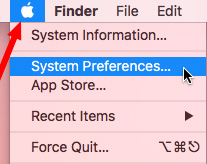
Open System Preferences; it’s under the Apple logo in the top left corner of your screen.

Open Users & Groups, in the fourth row, by double-clicking the icon.
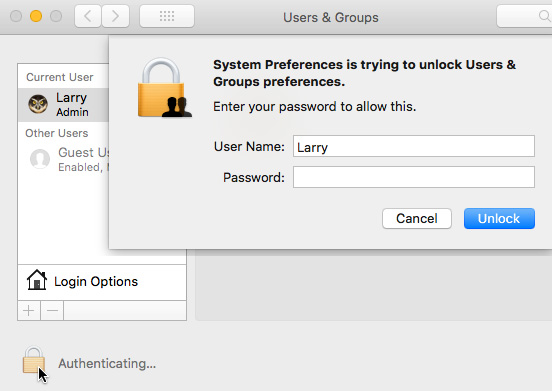
Click the Authenticating padlock icon to unlock these settings. Enter your computer user name and password.
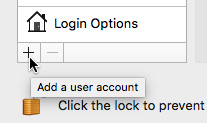
Click the Plus icon to create a new user account.
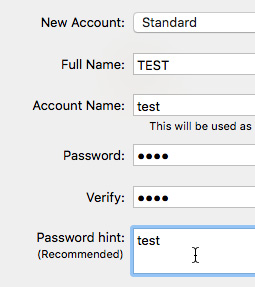
This new account is going to last a VERY short time, give it a simple user name and password. My favorite is “test”.

Turn off Automatic Login so you can select which user to login to your computer.
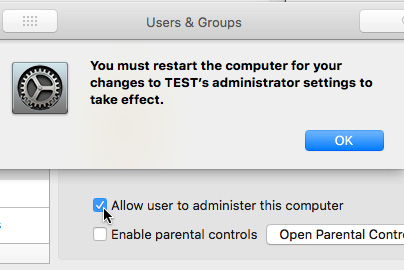
Then, and this is really important, CHECK Allow user to administer this computer. When you do, your system will need to restart.
Restart your computer and log into the new user account you just created.
IMPORTANT NOTE: Any files stored in your old Home directory are NOT available to you when you log in as this new user. This is one of the key reasons I strongly recommend never storing projects or media in the Home directory.
Open Final Cut and a recent Library to see if things are working better. If so, great. This means that you can edit logged in as the new user until you can get your computer serviced by Apple. If things are still not working, go on to the next section.
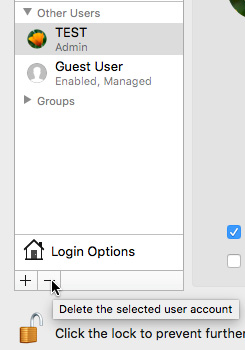
By the way, once you’ve tested your system, and assuming you don’t need to use this new user as a temporary editing login, you can delete the user you just created. Click the Minus icon.
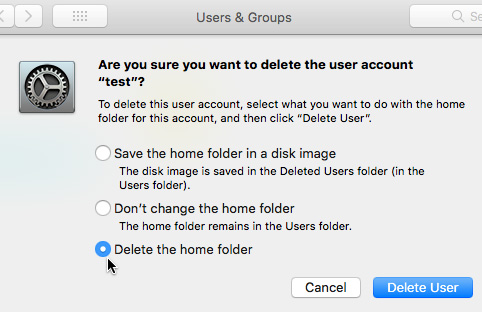
And, when the system asks what to do with the Home Directory, just trash it. There’s no need to save a test system.
STEP 7: CONTACT APPLE SUPPORT
After you’ve done these basic steps, if you are still having problems, it is time to contact Apple Support for more sophisticated help. To save you time at the start of your support call, be sure to tell them what you’ve done.
Having system problems is a HUGE frustration. I hope these steps will get you back and running in no time.
2,000 Video Training Titles
Edit smarter with Larry Jordan. Available in our store.
Access over 2,000 on-demand video editing courses. Become a member of our Video Training Library today!
Subscribe to Larry's FREE weekly newsletter and
save 10%
on your first purchase.
16 Responses to Trouble-Shoot Your Apple Final Cut Pro X System [u]
As alway Larry – THANK YOU THANK YOU THANK YOU, for putting ‘pen to paper’ and sharing this stuff. For free. Again. Great info and resource to have when World’s Collide inside my Mac.
Stu Aull
Arizona
Stu:
Glad you like it. Happy to help.
Larry
Thanks!
Thanks, Larry, for this and all the other great info you’ve provided. We’re all really really grateful! And may I say, I loved the remark you did at the end of one podcast where you went into how the tone and spirit of words means as much as the words themselves.
Bruce:
Smile… Thanks for the kind words!
Larry
A good way to do is to create a clone of your system at the end of each week.
That the best way to be on work rapidly. Thank you for your good tips.
[…] by Larry Jordan […]
[…] by Larry Jordan […]
Thanks Larry. I wish we had this literally 4 days ago. Went thru 5 apple Techs (3 of them Pro Apps Senior techs and 1 OS tech, over 8 hours on the phone over 2 days, due to the exact issues you are mentioned. Your “how to” above was EXACTLY what they had me do. Now up an running, including having to install “Sierra”-(was on “El Capitan)
1 cool “fix they did” you can share. This is for an overall “sluggish running Mac”.
Quit all, and turn off the Mac. Then “unplug it”. Then, push the “on button and hold for approx 1 sec. This drains the “SMC”- Think it was called the System Management Controller”. Wait for a few seconds, plug back in and start the mac up as usual. For me, the mac started quicker, desktop appeared quicker, Wacom pad operating sooner, all programs opened faster. Wow. 2014 27″ Core i7 iMac 32Ram, NVIDIA GeForce GTX 780M 4096 MB, with 12 TB Pegasus Thunderbolt Array
Different methods on different Macs:
https://support.apple.com/en-us/HT201295
Ian:
Thanks for sharing this link. My experience, though, is that the SMC is rarely the cause of problems. I would caution to use this technique later, rather than earlier, in the trouble-shooting process.
Larry
Thank you Larry! Always excellent.
One thing is that I wasn’t aware that we could “call Apple Support” . . . No matter what I do to report my iMac crashes, etc., they seem to ignore me, it seems. Guess they’re just too overwhelmed to respond to any individual?
George:
Don’t forget that Apple has an 800 number you can call for support in the US, plus Genius locations at all Apple Stores.
Larry
My boot up drive is an OWC SSD running from an external Thunderbolt-1 dock. Do you know if it’s safe to use Apple’s Disk Repair utility on an external SSD like this? I thought OWC’s SSDs had their own internal maintenance routines.
J.
I would expect that it would. HOWEVER, to be safe, please verify with OWC Support before using an Apple Utility.
It never hurts to ask first, before you have problems, just so you know.
Larry
Also, so hat es sich zugetragen: Ich habe die Betaversion von Mac OS Catalina installiert. Und es ist genau das passiert, was in solchen Fällen natürlich passiert: Mein produktives System hat aufgehört, produktiv zu sein. Das meiste läuft zwar noch. Doch genau jenes Programm, für das ich den Mac hauptsächlich benötige, hat den Betrieb eingestellt. Es handelt sich um Final Cut Pro, mit dem ich meine Videos schneide. Das stürzt einige Momente nach dem Start ab – und zwar auch dann, wenn man die gängigen Fehlerbehebungsmassnahmen durchexerziert.
– – –
(Translation) So, that’s how it happened: I installed the beta version of Mac OS Catalina. And that’s exactly what happened in such cases, of course: My productive system has stopped being productive. Most of it is still running. But just that program, for which I mainly need the Mac, has ceased operations. It’s Final Cut Pro, which I use to cut my videos. This crashes a few moments after the start – even if you have the usual troubleshooting measures.